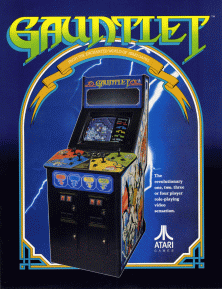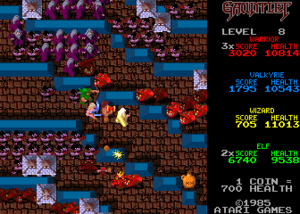Gauntlet (1985 video game) facts for kids
Quick facts for kids Gauntlet |
|
|---|---|

Arcade flyer
|
|
| Developer(s) | Atari Games (arcade) Tengen (NES) |
| Publisher(s) | Arcade
Tengen U.S. Gold |
| Designer(s) | Ed Logg |
| Programmer(s) | Bob Flanagan |
| Artist(s) | Sam Comstock Susan G. McBride Alan J. Murphy Will Noble |
| Composer(s) | Arcade/NES Hal Canon Earl Vickers Atari ST 2 Bit Systems Replay Amstrad/Spectrum Ben Daglish Master System Tiertex |
| Series | Gauntlet |
| Platform(s) | Arcade, Amstrad CPC, Atari ST, Apple II, Apple IIGS, Macintosh, Commodore 64, Atari 8-bit family, MSX, Master System, NES, Genesis, ZX Spectrum, MS-DOS, PlayStation |
| Release date(s) | Arcade |
| Genre(s) | Hack and slash Dungeon crawl |
| Mode(s) | Single-player, 4-player multiplayer |
| Arcade system | Atari Gauntlet |
Gauntlet is a super fun arcade game from 1985. It's a fantasy adventure where you play as a hero exploring mazes and fighting monsters! It was one of the first games where up to four players could team up and explore a dungeon crawl together. The game was inspired by an older game called Dandy and also has some similarities to Time Bandit.
The arcade version of Gauntlet first came out in November 1985. It was initially available as a big machine for four players. Later, in June 1986, a smaller two-player version was released.
Contents
How to Play Gauntlet: Exploring Dungeons
In Gauntlet, you explore many mazes from a top-down view. Your main goal is to find the exit in each level. As you play, you can pick up special items. These items can give you more health, open locked doors, or give you magic potions. Magic potions are super helpful because they can destroy all enemies on the screen!
Choosing Your Hero: Characters in Gauntlet
You get to pick one of four cool fantasy characters to play as:
- Thor: He's a strong warrior who is great at fighting up close.
- Merlin: He's a powerful wizard with the strongest magic attacks.
- Thyra: She's a brave valkyrie with the best armor to protect her.
- Questor: He's a speedy Elf who moves faster than anyone else.
Each character has special strengths. In the four-player game, your character is set by where you stand at the machine. In the two-player game, you can choose your hero at the start.
Facing Foes: Enemies and Challenges
You'll meet many different fantasy monsters in the mazes. These include ghosts, grunts, demons, and sorcerers. Each enemy comes from special "generators" that you can destroy. If you destroy a generator, no more enemies of that type will appear from there!
The most dangerous enemy is Death. Death can only be defeated by using a magic potion. If you don't use a potion, Death will just disappear after taking some of your health. There are no big "boss" enemies in this game, but Death is definitely a challenge!
Staying Alive: Health and Cooperation
Your character's health slowly goes down on its own, like a timer. When you touch an enemy, your health drops even faster. If your health reaches zero, your character dies. But don't worry! You can keep playing by putting in another coin (a "game credit") right after you die. This brings your character back to life with full health.
Working together is key in Gauntlet! Players need to share food items to keep their health up. You can also work together to lure monsters into good spots to defeat them. Your final score is divided by how many credits you used, so using fewer coins means a better score!
The Voice of Gauntlet: Famous Phrases
Gauntlet is famous for its narrator's voice. The voice gives you tips and comments on the game. You'll hear things like:
- "Shots do not hurt other players, yet."
- "Remember, don't shoot food."
- "Elf shot the food!"
- "Warrior needs food, badly!"
The narrator also says things like, "I've not seen such bravery!" or warns you when your health is low: "Your life force is running out!"
Controlling Your Hero: The Arcade Cabinet
The four-player Gauntlet arcade machine is wider than most. This is so four people can play comfortably at once. Each player has a joystick to move their character. They also have two buttons: one for shooting (a ranged attack) and one for using magic. The magic button also starts the game.
Creating Gauntlet: Game Development
The idea for Gauntlet came from game designer Ed Logg. He was inspired by his son's interest in the paper-based game Dungeons & Dragons. He also liked a four-player game for the Atari 8-bit family called Dandy.
The game was developed between 1983 and 1985. It was first called Dungeons, but the name had to be changed in 1985 to Gauntlet. This game was special because it was Atari's first arcade game to use a voice synthesizer chip, which made the famous narrator's voice possible!
The Dandy Game Dispute
Ed Logg, one of the creators of Gauntlet, was inspired by the game Dandy. Dandy was made by John Palevich for the Atari 8-bit computers in 1983. After Gauntlet came out, John Palevich thought it was too similar to his game. They settled the issue without going to court. John Palevich even received a Gauntlet arcade machine!
Gauntlet on Other Platforms: Ports and Expansions
Gauntlet was so popular that it was made available on many different home computers and game consoles. These included:
- MS-DOS
- Apple II
- Macintosh
- MSX
- Nintendo Entertainment System (NES)
- Apple IIGS
- Master System
- Atari ST
- Commodore 64
- Atari 8-bit family
- Amstrad CPC
- ZX Spectrum
- PlayStation 1 (as part of a collection)
The NES version was the first game developed in the United States specifically for the NES!
More Levels: The Deeper Dungeons
An expansion pack called Gauntlet: The Deeper Dungeons was released in 1987. It added 512 brand new levels to the game! Many of these levels were designed by players who entered a competition. Reviewers said these new levels were much harder than the original ones.
The Gauntlet Series: Sequels and Legacy
Gauntlet was a huge hit and led to many more games!
- The first sequel was Gauntlet II in 1986.
- Later games included Gauntlet Legends (1998), Gauntlet Dark Legacy, and Gauntlet: Seven Sorrows.
- The original Gauntlet arcade game can still be played today in game collections like Midway Arcade Treasures and Midway Arcade Origins.
- The game series was also rebooted in 2014 with a new game simply called Gauntlet.
See also
 In Spanish: Gauntlet (videojuego) para niños
In Spanish: Gauntlet (videojuego) para niños


